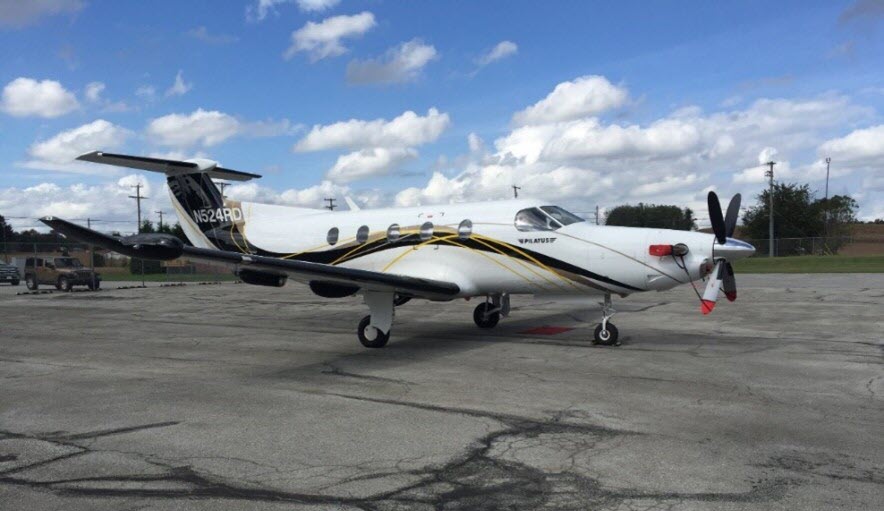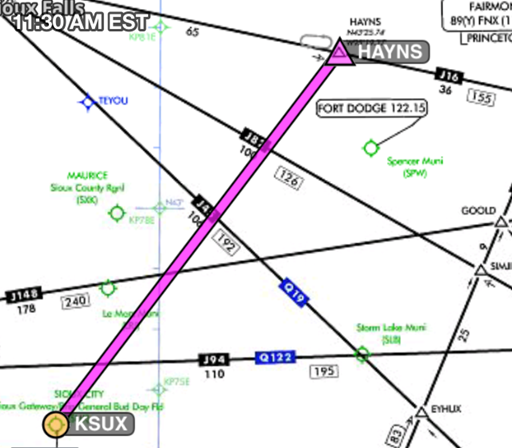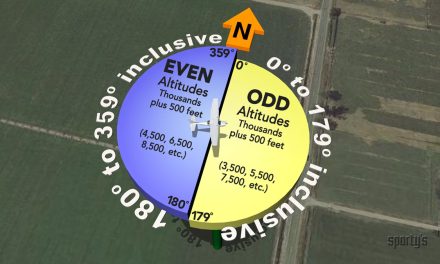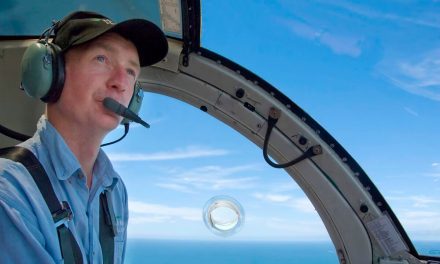Why You Should Practice the ‘Impossible Turn’
By Joel A. Turpin
ATP CFII, FAA Master Pilot
INTRODUCTION
Having an engine fail right after takeoff while flying a single engine airplane is every pilot’s worst nightmare. It requires immediate action along with quick, life or death decision making. Assuming the engine cannot be restarted, the pilot has only two options; land straight ahead, or attempt to return to the departure airport. The objective of this tutorial is to explore the second option, which is the engine out return to the departure airport.
Unlike the engine out forced landing from altitude, this one will end quickly with the outcome based on many factors. Some of these include the altitude when the engine fails, weather, departure runway length, wind, local terrain, and whether the failure occurs during day or night.
For this discussion, it is assumed we are flying a complex single engine airplane equipped with a constant speed propeller.
DISCLAIMER!
It is the Pilot in Command’s decision whether to land straight ahead or attempt to return to the departure airport, and he or she alone is responsible for the outcome. This decision will be based on the height above the ground when the engine fails, and whether it is day or night.
Below about 700 feet AGL, a return may not be possible and a landing straight ahead may be the only option. If the failure occurs at a higher altitude or at night, attempting the return maneuver may be the better option.
Note: The techniques below do not guarantee a safe return following and engine failure on takeoff. They are only intended to improve the chances of a successful outcome.
MY PERSONAL EXPERIENCE WITH THE RETURN TO THE FIELD MANEUVER
I fly the Pilatus PC-12NG professionally, and am based on a mountain top airport surrounded by hilly, tree covered terrain (KMPO). There are few options for a successful off airport, engine out forced landing. For this reason, I have become student of the return to the field maneuver for engine failure on takeoff. But I have two factors that work in my favor when departing my home airport.
First, I fly a turbine powered airplane, and turbine engines rarely fail. And second, I get to practice the engine failure return to the field maneuver once each year in the flight simulator during my recurrent training. In fact, it is the final maneuver during the check ride. The scenario goes like this.
I take off and my engine fails at 800 feet AGL, sometimes with a 200 foot ceiling, and it is my job to land back at the departure airport. Failure to make a safe return means failure of the check ride. In the 6 years I have been doing recurrent simulator training, using the techniques listed below, I have never failed to make a successful engine out return to the field. While my experience is with a turboprop airplane, the techniques are viable for all single engine airplanes.
TRAINING FOR THE ENGINE OUT RETURN MANEUVER
An engine failure on takeoff and return ideally requires a left 270 degree turn to a base leg followed by a right 90 degree turn to final. As a flight instructor, I find it nearly impossible to teach this maneuver at an airport because it involves landing down wind and against the flow of traffic.
For this reason, when training in the airplane, I use a long straight road in a remote area to simulate a runway. I will then have my student fly upwind along the road, descend to 500 feet AGL, then simulate a takeoff. At 1000 feet AGL, I will “fail” the engine and have the student use the techniques outlined below to practice the return maneuver to get lined up on the road for a “landing” in the opposite direction, using a low approach only. But even this method is not ideal. The best and safest method is to practice the maneuver in a flight simulator.
IF A RETURN TO THE AIRPORT DECISION IS MADE
If the decision is made to attempt to return to the takeoff runway after an engine failure, here are some tips to help make it a success. Time is of the essence, so do not hesitate to take the action as stated below. Also, you will not have time to read a checklist, so everything will have to be done instinctively, quickly, and by memory. This is why it is imperative that flight instructors practice the engine out and return maneuver during simulator training.
Instructors should also review this maneuver on the ground during briefing for a flight review or any other type of training. It is up to the instructor or trainee whether it is actually practiced in the airplane. However, one maneuver should always be practiced to proficiency in flight, and that is the forward slip.
The forward slip is the maneuver that can save your life in any kind of forced landing. See my article in the archives of this magazine entitled The Forward Slip…The Forgotten Maneuver That Can Save Your Life. If it cannot be located, contact me using my email address at the end of this article and I will send you a copy.
I have used the slip on several of my successful engine out returns for a landing in the simulator. And mastery of the slip is one of the maneuvers emphasized on every flight review I conduct.
Again, the decision to attempt a return will be based on the pilot’s judgement. If a suitable field for a forced landing is available straight ahead during daylight hours, that may be the best option. However, if an engine fails at a higher altitude or at night, the return to the airport may be the best option.
Unless your engine failed mechanically, which you will hear, the most likely cause is an interruption in fuel flow. This is why the first thing to do is switch fuel tanks and turn the boost pump on.
RECOMMENDED TECHNIQUES FOR THE RETURN MANEUVER
1. FUEL BOOST PUMP ON
2. SWITCH FUEL TANKS.
If the engine does not restart.
3. PROP CONTROL LEVER FULL AFT/LOW RPM
This puts your prop in a semi feathered position. Do not delay in accomplishing this step. A windmilling prop creates drag equivalent to a parachute the same diameter as your propeller which will dramatically reduce glide distance.
4. APPROACH FLAPS
5. MAKE AN IMMEDIATE LEFT TURN USING A 45 DEGREE BANK ANGLE
6. SLOW TO BEST GLIDE SPEED
(Use best glide distance speed if one is published for your airplane)
The 45 degree bank, approach flaps, and slowing to best glide speed keeps the diameter of your turn tighter than if you use a shallower bank angle and or a higher airspeed. The approach flaps position also lowers your stall speed, which will be necessary in a 45 degree bank. The turn to the left will bring the airport in view sooner than a turn to the right.
7. KEEP THE NOSE DOWN!
Many pilots try the return maneuver with a real engine failure only to stall because they are afraid to keep the nose down to maintain airspeed close to the ground. Monitor your airspeed closely.
You will need to make a left 270 degree turn, which hopefully puts you on a base leg, followed by a right 90 degree turn to line up with the runway. Failure to keep the turn diameter as tight as possible may put you out of position to make the runway, or even the field. Keep in mind you might be landing with a significant tailwind.
After about 90 degrees of turn, the departure airport should come into view. If the airport has more than one runway, another runway or just landing on the airport property, may be a better option than the departure runway. This is why the initial turn should be to the left.
8. IF YOU ARE TOO HIGH
Move the prop control lever full forward to increase drag, lower full flaps, lower the gear, and put the airplane into a slip. Do not be afraid to use full aileron and full opposite rudder for the slip if that is what is required – if not too high.
9. DO NOT LOWER THE GEAR AND FULL FLAPS UNTIL THE FIELD IS MADE
SOME THOUGHTS ON RETURNING TO THE FIELD VERSUS LANDING STRAIGHT AHEAD
Contrary to what the conventional thinking is, landing straight ahead may not be the best option, especially at night. Landing straight ahead may result in a collision with trees or terrain a mile or more from the airport. Emergency equipment may not even be able to access your crash site, and even if they can, it will take a long time to reach you as there might not be roads leading them to the scene. And the collision with those trees or terrain could result in serious injury.
Assuming there is sufficient altitude for the return, it is better to make your landing on the airport property, even if it is not on a runway. You might have to land gear up, or in the grass next to a runway, or on a taxiway. The objective is to save the lives of you and your passengers, even at the expense of the airplane. Airplanes can be replaced, but lives cannot.
At towered airport, the emergency equipment will be at the scene in minutes. At an uncontrolled field, the equipment will have easy access to where your airplane comes to rest. And landing on the airport property hopefully avoids colliding with some fixed object.
My belief for this came when I was a pilot for United Airlines. On July 19, 1989, one of our DC-10s, which I was following as a crewmember on a B-727, had a massive center engine failure about 60 miles northeast of Sioux City, Iowa. Turbine blades exited the side of the engine and cut all of the hydraulic lines rendering the flight controls useless.
Captain Al Haynes, through superior airmanship and using just the throttles, was able to steer the wounded DC-10 back to the Sioux City airport, which was behind them. Unfortunately, when they crossed the runway threshold, the big DC-10 rolled left and the wing struck the ground causing the airplane to crash into a massive fireball.
Because they had crashed on an airport, fire trucks and other emergency equipment and personnel were on the scene in seconds. Of the 297 people on board, 197 survived, including Captain Haynes and the other three pilots on the flight deck. Had they crashed somewhere miles from the field, all 297 would have perished.
As always, I hope the information I have provided in this this tutorial has been of value to my esteemed readership. Piper Owner invites members to share their thoughts on this article on the forum.







